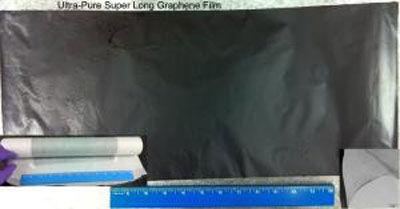| Jun 06, 2011 |
Researchers develop super long, ultra-pure graphene film
|
|
(Nanowerk News) The importance of graphite was realized in the late nineteenth century. However, a synthetic method developed by Hummer laid the foundation for the development of intercalated layered graphite. The term 'graphene' which originated from graphite gained immense importance after the Nobel Prize in Physics was awarded to two scientists in 2010 for their work with the novel material.
|
|
Graphene can be manufactured in the lab, but the scale-up is still a challenge for scientists that limit its use in industry. Additionally, functionalized graphene remains suspended in solution, which poses further limitations on its use. While some are still making tiny graphene film on filter papers, researchers at the University of Hawai'i at Manoa have invented a technology that can transform graphite powder into super long, ultra-pure graphene film.
|
 |
| Super long graphene film
|
|
A synthetic procedure that does not require a binder has been developed by Dr. Atul Tiwari, an associate researcher at UH Manoa, in collaboration with Anupama Chaturvedi, a former UH Manoa mechanical engineering student. Tiwari claims that he can now manufacture super long, graphene sheet/film in a continuous roll.
|
|
The film can be dissolved completely in solvent using a common mixing technique. The stable graphene film can also be rolled into thin sheets that can be transported without the need of special shipping and packaging. "This will help manufacturers incorporate graphene into consumer products, which will make their products light weight and super strong," noted Chaturvedi.
|
|
Added Tiwari, "This material has shown interesting properties and the invention may revolutionize the manner in which graphene is being used in research and industry."
|
|
The super long graphene sheet/film can be used as low dielectric constant material for microelectronics, membranes for fuel cells, fillers for fiber reinforced polymer composites, coatings for the sizing of the fibers, coatings for corrosion protection, flexible grids for the organic solar cells, flexible liquid crystal displays, ultra-capacitors, batteries and other as yet to be determined uses.
|
|
Certain uses of this technology are being currently explored by a Hawai'i company. This research was partially funded by the Office of Naval Research.
|

